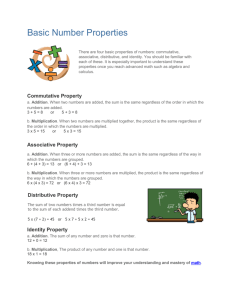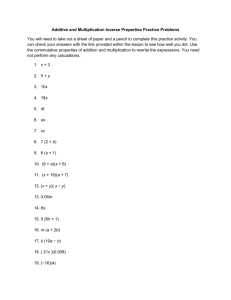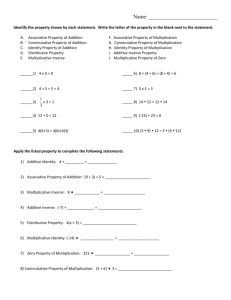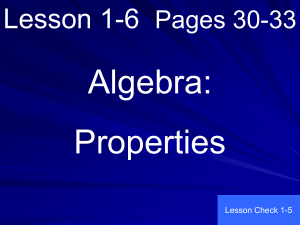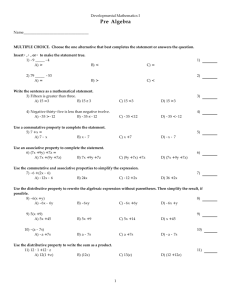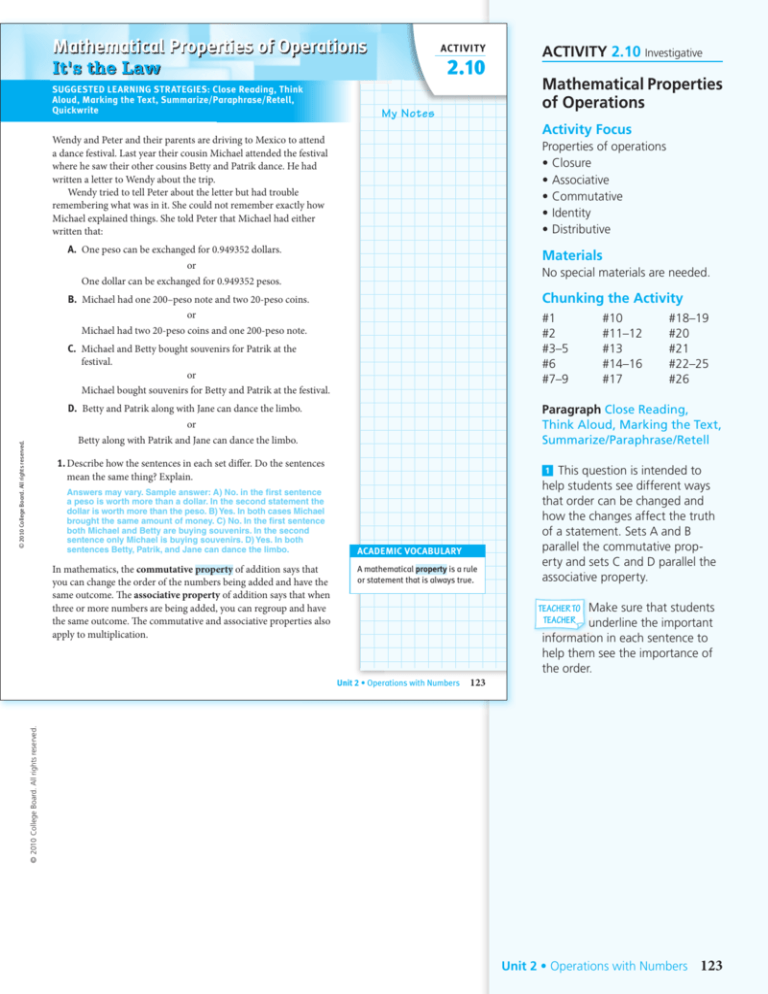
Mathematical Properties of Operations
It's the Law
SUGGESTED LEARNING STRATEGIES: Close Reading, Think
Aloud, Marking the Text, Summarize/Paraphrase/Retell,
Quickwrite
ACTIVITY
ACTIVITY 2.10 Investigative
2.10
Mathematical Properties
of Operations
My Notes
Activity Focus
Wendy and Peter and their parents are driving to Mexico to attend
a dance festival. Last year their cousin Michael attended the festival
where he saw their other cousins Betty and Patrik dance. He had
written a letter to Wendy about the trip.
Wendy tried to tell Peter about the letter but had trouble
remembering what was in it. She could not remember exactly how
Michael explained things. She told Peter that Michael had either
written that:
Properties of operations
• Closure
• Associative
• Commutative
• Identity
• Distributive
A. One peso can be exchanged for 0.949352 dollars.
Materials
or
No special materials are needed.
One dollar can be exchanged for 0.949352 pesos.
Chunking the Activity
B. Michael had one 200–peso note and two 20-peso coins.
or
#1
#2
#3–5
#6
#7–9
Michael had two 20-peso coins and one 200-peso note.
C. Michael and Betty bought souvenirs for Patrik at the
festival.
or
Michael bought souvenirs for Betty and Patrik at the festival.
© 2010 College Board. All rights reserved.
or
Betty along with Patrik and Jane can dance the limbo.
1. Describe how the sentences in each set differ. Do the sentences
mean the same thing? Explain.
In mathematics, the commutative property of addition says that
you can change the order of the numbers being added and have the
same outcome. The associative property of addition says that when
three or more numbers are being added, you can regroup and have
the same outcome. The commutative and associative properties also
apply to multiplication.
1 This question is intended to
help students see different ways
that order can be changed and
how the changes affect the truth
of a statement. Sets A and B
parallel the commutative property and sets C and D parallel the
associative property.
ACADEMIC VOCABULARY
A mathematical property is a rule
or statement that is always true.
M
Make sure that students
u
underline the important
informatio
information in each sentence to
help them see the importance of
the order.
TEACHER TO
TEACHER
Unit 2 • Operations with Numbers
123
1/28/10 11:47:50 PM
© 2010 College Board. All rights reserved.
123-130_SB_MS1_2-10_SE.indd 123
#18–19
#20
#21
#22–25
#26
Paragraph Close Reading,
Think Aloud, Marking the Text,
Summarize/Paraphrase/Retell
D. Betty and Patrik along with Jane can dance the limbo.
Answers may vary. Sample answer: A) No. in the first sentence
a peso is worth more than a dollar. In the second statement the
dollar is worth more than the peso. B) Yes. In both cases Michael
brought the same amount of money. C) No. In the first sentence
both Michael and Betty are buying souvenirs. In the second
sentence only Michael is buying souvenirs. D) Yes. In both
sentences Betty, Patrik, and Jane can dance the limbo.
#10
#11–12
#13
#14–16
#17
Unit 2 • Operations with Numbers
123
2 Close Reading, Marking the
Text, Create Representations,
Look for a Pattern Students are
determining whether addition is
commutative. Have students test a
few other examples.
ACTIVITY 2.10
continued
Mathematical Properties of Operations
It's the Law
My Notes
2. Look at addition.
a. What does 3 + 5 equal? 8
b. What does 5 + 3 equal? 8
35 Quickwrite Students will
find examples to make decisions
about whether subtraction,
multiplication, and division are
commutative.
c. Is addition commutative? Explain.
Explanations may vary. Sample answer: Yes, because changing
the order you add does not change the answer.
3. Is subtraction commutative? Explain.
Examples may vary. Sample answer: The operation is not
commutative. For example, 7 - 5 = 2 but 5 - 7 = -2
6 Close Reading, Marking the
Text, Create Representations,
Look for a Pattern Students are
determining whether addition is
associative. Have students test a
few other examples.
79 Quickwrite Students will
find examples to make decisions
about whether subtraction,
multiplication, and division are
associative.
SUGGESTED LEARNING STRATEGIES: Close Reading,
Marking the Text, Create Representations, Look for a
Pattern, Quickwrite
4. Is multiplication commutative? Explain.
Examples may vary. Sample answer: Yes, 4 × 5 = 20 and
5 × 4 = 20
MATH TERMS
A numerical expression is a collection of numbers and symbols,
such as +, -, ×, and ÷, and
does not contain an equal sign.
5. Is division commutative? Explain.
Examples may vary. Sample answer: The operation is not
commutative. For example, 20 ÷ 10 = 2 but 10 ÷ 20 = 0.5
6. When evaluating a numerical expression, you must first
evaluate anything that is in parentheses.
a. What is the value of (3 + 5) +1? 9
© 2010 College Board. All rights reserved.
ACTIVITY 2.10 Continued
b. What is the value of 3 + (5 + 1)? 9
c. Is addition associative? Explain.
Answers may vary. Sample answer: Yes. (3 + 5) + 1 = 8 + 1 = 9
and 3 + (5 + 1) = 3 + 6 = 9.
7. Is subtraction associative? Explain.
Answers may vary. Sample answer: The operation is not
associative. For example, (8 - 5) - 2 = 1 but 8 - (5 - 2) = 5.
8. Is multiplication associative? Explain.
Answers may vary. Sample answer: Yes. (4 × 5) × 2 = 20 × 2 = 40
and 4 × (5 × 2) = 4 × 10 = 40.
9. Is division associative? Explain.
Answers may vary. Sample answer: The operation is not
associative. For example, (20 ÷ 10) ÷ 2 = 2 ÷ 2 = 1 but
20 ÷ (10 ÷ 2) = 20 ÷ 5 = 4
124 SpringBoard® Mathematics with Meaning™ Level 1
12/16/09 5:57:57 P
1
© 2010 College Board. All rights reserved.
123-130_SB_MS1_2-10_SE.indd 124
124 SpringBoard® Mathematics with Meaning™ Level 1
Mathematical Properties of Operations
ACTIVITY 2.10
It's the Law
ACTIVITY 2.10 Continued
continued
0 Create Representations,
SUGGESTED LEARNING STRATEGIES: Create Representations,
Look for a Pattern, Guess and Check, Quickwrite
Look for a Pattern, Guess and
Check This question is leading
students to find the additive
identity.
My Notes
TRY THESE A
a. Rewrite 3 + 2 using the commutative property. 2 + 3
a Quickwrite The intent of this
Identify the property illustrated in each part.
b. (2 × 8) × 9 = 2 × (8 × 9) Associative Property
question is that students see there
is only one additive identity.
1 __
1
1
1
1
1 __
__
__
__
c. __
3 + 5 + 7 + 1 = 3 + 5 + 7 + 1 Associative Property
b Quickwrite The intent of this
(
) (
)
(
)
question is to connect the use of
the additive identity to previous
knowledge.
d. (3.6 + 5.7) = 5.7 + 3.6 Commutative Property
Give an example of each.
e. Commutative Property of multiplication using fractions.
1 × __
2 = __
2 × __
1
Answers may vary. Sample answer: __
4 3 3 4
f. Associative Property of addition using whole numbers.
Answers may vary. Sample answer: (5 + 7) + 13 = 5 + (7 + 13)
10. In each box write a number that makes the number sentence
true. What do you notice about the numbers in all the boxes?
3+ 0 =3
© 2010 College Board. All rights reserved.
0 +3=3
7+ 0 =7
0 +7=7
When the additive identity is added to any number, the sum is
that same number.
11. Each number you found in Item 10 is called an additive
identity. List as many numbers as you can that would be
examples of additive identities. How many did you find?
The additive identity is 0. Zero is the only additive identity. There
is no other number that you can add to any whole number and
have that whole number be the sum.
12. Give three examples of applying the additive identity. Use a
whole number, a fraction, and a decimal.
2,
2 + 0 = __
Answers may vary. Sample answer: 3 + 0 = 3; __
3
3
and 1.7 + 0 = 1.7
Unit 2 • Operations with Numbers
12/16/09 5:57:59 PM
© 2010 College Board. All rights reserved.
PM
123-130_SB_MS1_2-10_SE.indd 125
125
Unit 2 • Operations with Numbers
125
ACTIVITY 2.10 Continued
c Close Reading, Marking the
Text, Look for a Pattern This
question is leading students to
find the multiplicative identity.
ACTIVITY 2.10
continued
Mathematical Properties of Operations
It's the Law
My Notes
SUGGESTED LEARNING STRATEGIES: Close Reading,
Marking the Text, Create Representations, Look for a
Pattern, Quickwrite
13. Fill in each box with a number that makes the number
sentence true. What do you notice about the numbers in
all the boxes?
d Quickwrite The intent of this
question is for students to see that
there is only one multiplicative
identity.
3× 1 =3
1 ×3=3
7× 1 =7
ef Quickwrite If students are
1 ×7=7
having problems with these questions ask them to evaluate 7 – 0
and 0 – 7.
When any whole number is multiplied by the multiplicative identity, the product is that whole number.
14. Each number you found in Item 13 is called a multiplicative
identity. List as many numbers as you can that would be
examples of multiplicative identities. How many did you find?
g Close Reading, Quickwrite
The intent of this question is to
connect the multiplicative identity
to previous knowledge.
The multiplicative identity is 1. There is only one multiplicative
identity. There is no other number by which any whole number
can be multiplied and have that whole number be the product.
15. Explain why there is not an identity for subtraction.
Suggested Assignment
Examples may vary. Sample answer: 7 - 0 = 7 but 0 - 7 ≠ 7.
CHECK YOUR UNDERSTANDING
p. 130, #1–5
16. Explain why division does not have an identity.
UNIT 2 PRACTICE
p. 137, #65–69
17. You used the Property of One to find equivalent fractions in
Unit One. Now use the multiplicative identity to explain why
the Property of One works.
© 2010 College Board. All rights reserved.
Examples may vary. Sample answer: 7 ÷ 1 = 7 but 1 ÷ 7 ≠ 7.
Answers may vary. Sample answer: When you multiply both the
numerator and denominator of a fraction by the same number,
you are multiplying the fraction itself by a representation of 1.
The Property of One says that the equivalent fraction that is
formed is the same as the original fraction.
126 SpringBoard® Mathematics with Meaning™ Level 1
12/16/09 5:58:02 P
1
© 2010 College Board. All rights reserved.
123-130_SB_MS1_2-10_SE.indd 126
126 SpringBoard® Mathematics with Meaning™ Level 1
Mathematical Properties of Operations
ACTIVITY 2.10
It's the Law
ACTIVITY 2.10 Continued
continued
h Close Reading, Quickwrite
SUGGESTED LEARNING STRATEGIES: Close Reading,
Quickwrite
The intent of this question is to
see if students understand closure
under addition.
My Notes
A set of numbers is closed under an operation if you can use that
operation on any two members of the set, and the result of the
operation is also a member of the set. For example, the set of whole
numbers is not closed under subtraction because 7 and 9 are whole
numbers, but 7 - 9 = -2 and -2 is not a whole number.
i Close Reading, Quickwrite
The intent of this question is to
see if students understand closure
under multiplication.
The numbers 1, 2, 3, 4, and so on
are called natural numbers.
18. Explain why each set is or is not closed under addition.
The numbers 0, 1, 2, 3, 4, and so
on are called whole numbers.
a. natural numbers
The set of integers consists of
all of natural numbers, their
opposites, and zero.
The natural numbers are closed under addition because when
you add two natural numbers you get a natural number.
b. whole numbers
The whole numbers are closed under addition because when
you add two whole numbers you get a whole number.
c. integers
The integers are closed under addition because when you add
two integers you get an integer.
d. even integers
The even integers are closed under addition because when you
add two even integers you get an even integer.
e. odd integers
© 2010 College Board. All rights reserved.
The odd integers are not closed under addition because when
you add two odd integers you get an even integer.
19. Explain why each set is or is not closed under multiplication.
a. natural numbers
Natural numbers are closed under multiplication because when
you multiply two natural numbers you get a natural number.
b. whole numbers
Whole numbers are closed under multiplication because when
you multiply two whole numbers you get a whole number.
c. even whole number
Even whole numbers are closed under multiplication because
when you multiply two even whole numbers you get an even
whole number.
d. odd whole numbers
Odd whole numbers are closed under multiplication because
when you multiply two odd whole numbers you get an odd
whole number.
Unit 2 • Operations with Numbers
12/21/09 12:17:06 PM
© 2010 College Board. All rights reserved.
PM
123-130_SB_MS1_2-10_SE.indd 127
127
Unit 2 • Operations with Numbers
127
ACTIVITY 2.10 Continued
ACTIVITY 2.10
continued
Mathematical Properties of Operations
It's the Law
j Close Reading, Quickwrite
This question introduces the
distributive property.
SUGGESTED LEARNING STRATEGIES: Close Reading,
Quickwrite
My Notes
Drew and Seth were in charge of collecting the money for the class
yearbook. They had collected the estimated cost of $10 a book from
each of the 16 girls and 14 boys in their class. The actual cost of the
yearbook was $8 a book.
k Close Reading, Create
Representations, Quickwrite
The intent of this question is to
give a pictorial representation of
the distributive property.
20. To figure out the total amount of money due back to the
class, Drew wrote the expression (16 + 14) × 2. Seth wrote the
expression 16 × 2 + 14 × 2. Do they both represent the amount
to be returned to the class? Explain.
Yes, The amounts are the same. Drew: (16 + 14) × 2 = 30 × 2 =
60; Seth: 16 × 2 + 14 × 2 = 32 + 28 = 60
Writing (16 + 14) × 2 = 16 × 2 + 14 × 2 is an example of using
the Distributive Property. Notice that the multiplication by 2 has
been distributed to both the 16 and the 14.
An area model is a way to visualize how the Distributive Property
works.
21. Study the area model and the equation written below it. Compare the rows and the columns and the total number of squares
in the three rectangles. Then compare the two expressions on
each side of the equation.
3
4
2 (3 4)
2
2 3
© 2010 College Board. All rights reserved.
2 4
a. How are they alike?
Answers may vary. Sample answer: There is the same number
of squares on both sides of the model; the area models all
have two rows; 2 is a factor in all the expressions.
You can distribute a number on
either side of the parentheses.
2 × (3 + 4) = 2 × 3 + 2 × 4
(3 + 4) × 2 = 3 × 2 + 4 × 2
b. How are they different?
Answers may vary. Sample answer: On the left side of the
model there is only one array and on the left side of the
equation there is only one expression, while on the right side
of the model there are two arrays and on the right side of the
equation there are two expressions.
128 SpringBoard® Mathematics with Meaning™ Level 1
12/16/09 5:58:06 P
1
© 2010 College Board. All rights reserved.
123-130_SB_MS1_2-10_SE.indd 128
128 SpringBoard® Mathematics with Meaning™ Level 1
Mathematical Properties of Operations
ACTIVITY 2.10
It's the Law
ACTIVITY 2.10 Continued
continued
l Close Reading, Create
SUGGESTED LEARNING STRATEGIES: Close Reading,
Create Representations, Quickwrite, RAFT
Representations, Quickwrite
The intent of this question is to
show a practical application of the
Distributive Property.
My Notes
22. You can use the Distributive Property to simplify problems.
a. Use parentheses to rewrite and evaluate 19 × 25 + 19 × 75.
The distributive property can be
very useful in simplifying a problem so that it can be solved using
mental math.
19 × (25 + 75) = 19 × 100 = 1900
b. Is the problem now easier to evaluate? Explain.
R
Remind students that this
is nothing new. Connect
to previous
previou knowledge by reminding them how they could multiply
21 × 2.50 by evaluating 20 ×
2.50 + 1 × 2.50.
TEACHER TO
TEACHER
Answers may vary. Sample answer: Yes, it can be done with
mental math instead of two long multiplications.
ACADEMIC VOCABULARY
23. Drew and Seth are also selling greeting cards to raise money
for the school band. They sold 21 boxes for $2.50 per box. They
need to find the total amount of money for their sales.
Using the Distributive Property
to rewrite an expression like
3 × 7 + 3 × 23 as 3 × (7 + 23)
is called factoring. You will use
factoring as you begin to study
algebra.
a. Seth used the Distributive Property to write the problem this
way:
21 × 2.50
(20 + 1) × 2.50
20 × 2.50 + 1 × 2.50
m Close Reading, Create Representations, Quickwrite The
intent of this question is to show
that there is more than one way
to represent a problem using the
distributive property. Students
should notice that you can distribute over more than two numbers.
Finish simplifying this expression for Seth.
50 + 2.50 = 52.50
WRITING MATH
The product 3 × (7 + 23) can be
written as 3(7 + 23).
b. Drew used the Distributive Property to write the problem
this way:
21 × 2.50
(10 + 10 + 1) × 2.50
10 × 2.50 + 10 × 2.50 + 1 × 2.50
n Close Reading, Create
Representations, Quickwrite
The intent of this question is to
show that you can distribute
multiplication over subtraction.
© 2010 College Board. All rights reserved.
Finish simplifying this expression for Drew.
25 + 25 + 2.50 = 50 + 2.50 = 52.50
READING MATH
The expression 3(7 + 23) consists of the two factors, 3 and
(7 + 23). The factor (7 + 23)
consists of two terms, 7 and 23.
c. Did the different ways Seth and Drew used the Distributive
Property give the same result? Explain.
Explanations may vary. Sample answer: Yes, because it was
the same product but they used different ways to distribute
the multiplication so that it was easy for each one to calculate.
d. Whose method did you like better? Explain.
CONNECT TO ALGEBRA
Answers may vary. Sample answer: I liked Seth’s way better
because it is faster and there are fewer calculations to make.
In algebra, you will use the
distributive property to simplify
algebraic expressions. Examples:
24. Drew noticed that they had counted incorrectly and that they
sold only 19 boxes. To find the total amount of money they collected, Drew must multiply $2.50 × 19. Explain how he can use
the Distributive Property with subtraction to do this.
n+n=1×n+1×n
= (1 + 1)n = 2n
Answers may vary. Sample answer: One possibility:
$2.50 × (20 - 1) = $2.50 × 20 - $2.50 × 1 = $50.00 - $2.50 = $48.50
3(n + 5) = 3 × n + 3 × 5
= 3n + 15
Unit 2 • Operations with Numbers
1/31/11 10:13:57 AM
© 2010 College Board. All rights reserved.
PM
123-130_SB_MS1_2-10_SE.indd 129
129
Unit 2 • Operations with Numbers
129
ACTIVITY 2.10
continued
Mathematical Properties of Operations
It's the Law
o Quickwrite
SUGGESTED LEARNING STRATEGIES: Close Reading,
Quickwrite
p Close Reading This question
My Notes
provides practice in writing and
evaluating expressions.
CHECK YOUR UNDERSTANDING
p. 118, #6–8
UNIT 2 PRACTICE
p. 137, #70–74
Fiona: 6 teddy bears
25. On a separate sheet of paper, write Drew and Seth a note.
Tell them how to use the Distributive Property when
multiplying. Use 1.36 × 20 and 1.36 × 12 as examples in your
note to them.
3 times as many key chains
1 as many posters
__
2
20 times as many stamps
26. Fiona and John collect things. They counted their collections
and decided to express all the amounts in terms of one of the
things. Their lists are shown to the left.
1 as many shells
__
3
John: 8 posters
Write and evaluate expressions for:
a. the number of things Fiona has. Answers may vary.
the same number of shells
1. 7; Commutative Property
(
)
1 = 149
1 + 20 + __
Sample answer: 6 + 6 3 + __
2
3
20 times as many stamps
2. 11; Additive Identity
4 times as many key chains
b. the number of stamps they both have. Answers may vary.
3. 8; Associative Property
1 as many teddy bears
__
c. how many more key chains John has than Fiona. Answers
Sample answer: 20(6 + 8) = 280
4
may vary. Sample answer: (4 × 8) − (3 × 6) = 14
4. 1; Multiplicative Identity
5. Explanations may vary. Sample
answer: Yes, if you add two
fractions, the sum will be a
number that can be expressed
as a fraction; for example,
_3_ + _1_ = _5_.
4
4
2
6 . Answers may vary. Sample
answer: 310 × (500 - 2) =
310 × 500 - 310 × 2 =
155,000 - 620 = 154,380
7. 53 × (4 + 6) = 53 × 10 = 530
8. 2 + 3 × 4; the sum of 2 and
the product of 3 and 4
9. The expressions are equivalent
because of the distributive
property. x + x + x = 1x +
1x + 1x = x(1 + 1 + 1) =
x3 = 3x
10. Answers may vary. Sample
answer: If you understand the
properties, you can use them
to make calculating simpler.
d. the number of things in all their collections Answers may
(
)
(
1 + 8 1 + 1 + 20 +
1 + 20 + __
vary. Sample answer: 6 1 + 3 + __
2
3
1 = 359
4 + __
4
)
© 2010 College Board. All rights reserved.
Suggested Assignment
Drew and Seth were talking about the calculations Drew did to find
the amount of money they collected. They wondered if it is always
best to use the Distributive Property when multiplying.
CHECK YOUR UNDERSTANDING
Write your answers on notebook paper.
Show your work.
7. Use the Distributive Property to simplify
53 × 4 + 53 × 6.
Copy and complete each number sentence to make
it true. State which mathematical property applies.
8. Write an expression for “2 more than
3 times 4” using mathematical symbols.
Describe your expression using
mathematical terms.
1. 7 × 3 = 3 ×
2. 11 =
3. 6 + ( + 4) = (6 + 8) + 4 4.
+0
× 10 = 10
5. Are fractions closed under addition? Explain.
9. Why is the expression 3x equivalent to the
expression x + x + x?
6. Simplify 310 × 498 using the Distributive
Property.
10. MATHEMATICAL Why are mathematical
R E F L E C T I O N properties useful?
130 SpringBoard® Mathematics with Meaning™ Level 1
123-130_SB_MS1_2-10_SE.indd 130
130 SpringBoard® Mathematics with Meaning™ Level 1
1/31/11 10:16:29 A
© 2010 College Board. All rights reserved.
ACTIVITY 2.10 Continued


